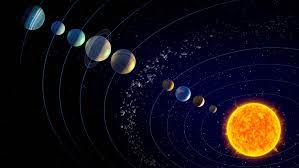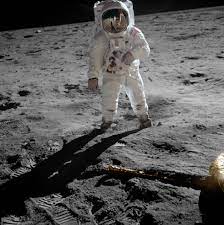Gravitation
We all know the earth goes around the sun, and the moon goes around the earth. Similarly, the other planets revolve around the sun, and their satellites revolve around them.
But have you ever wondered why these planets revolve around the sun?

The answer to this question is the force of gravitation, which we shall study in detail now.
Universal Law of Gravitation
Sir Isaac Newton gave the universal law of gravitation, which can be stated as follows:
F = GMm/d2
Where F: force experienced by the two bodies of mass M and m,
d: distance between the two bodies, and
G: Universal gravitation constant.
Question: Are there
any constraints on this law of gravitation?
Yes. Ideally speaking, this law is valid only for point
masses. The dimensions of the body should be negligible.
Question: Can we
still use it on objects, like planets?
Also yes. Despite the huge size of planets, they are so far apart from us that they look like very small objects. In other words, we can apply law of gravitation on bodies of large dimensions, provided the separation between them is many, many timesgreater than their dimensions.
Coming back to the formula, we haven’t described G yet. G is like a proportionality constant in the equation. The SI unit of G can be obtained by substituting the units of force, distance and mass in the equation as N m2 kg–2. The value of G was found out by Henry Cavendish (1731 – 1810) by using a sensitive balance. The accepted value of G is 6.673 × 10–11 N m2 kg–2.
Question: What can
you infer from the extremely small value of G?
This implies gravitation is a weak force. It is not appreciable unless bodies with huge masses are involved.
Question: What is the
importance of the universal law of gravitation?
The universal law of gravitation successfully explained several phenomena which were believed to be unconnected:
(i) the force that binds us to the earth;
(ii) the motion of the moon around the earth;
(iii) the motion of planets around the Sun; and
(iv) the tides due to the moon and the Sun.
Gravitational force of Earth
We will now focus on the force that binds us to the earth. It is also the force responsible for our weight. Note that mass is not the same as weight – mass is the measure of how much matter a body has.
Question: What gives rise to weight?
Weight is the force with which the earth pulls us towards its centre. In general, mass of a body is constant, while weight is not – it depends on external factors. Weight of a body on earth is given by mg, where m is its mass and g is acceleration due to gravity, as we will see next.
This is why astronauts face weightlessness in space – they are far away from earth (or any other planet of substantial gravitational force) to feel any force of gravity.

Free
fall and acceleration due to earth
When objects are allowed to fall freely, they fall towards the ground. Near the earth’s surface, they fall with a constant acceleration, called g. We can find the value of g as follows:
F = GmM/r2 = mg
Which implies:
g = GM/r2
Where G is the universal gravitational constant, M and r are the mass and the radius of the earth respectively.
G = 6.7 × 10–11 N m2 kg-2
M = 6 × 1024 kg
r = 6.4 × 106 m
Plugging in the values, we get g = 9.81 m/s2.
Question: If you weight 40 Kg according to a weighing machine, what is
the mass of your body?
The weighing machine measures the
weight, not mass. To find the mass, you need to divide the value by g, that is,
your mass is 40 kg/9.81 = 4.077 kg. Note that the weighing machine should
actually use the unit Newtons, since it
does not measure mass!
Fun fact: Due to the smaller size of the moon, the value of g on the
moon is only 1/6th of the value of g on earth.

Pressure
Have you ever wondered why heavier vehicles like buses and trucks have wider tires? Or, have you ever tried to cut something with a blunt knife? Or tried to cut paper with a blunt pair of scissors? It is certainly not as efficient as using a sharp knife, even if you apply the same force in both the cases. This means there is another quantity of interest here, which is called Pressure. We will define pressure, and then come back to see how it relates to these examples.
Pressure is simply the force per unit area. Its unit is N/m2. However, to honour the famous French physicist Blaise Pascal, 1N/m2 is also referred to as 1 Pascal, or 1 Pa for short. Pascal is the SI (System International) unit of pressure.
Pressure = force applied on a surface/ area of the surface where force is applied
Let’s see how it relates to our examples.
Question: Why does a truck have thicker wheels, compared to cars?
Trucks have greater mass, hence they have larger weight than cars. As such, the force applied by them on the roads is also much greater. To counter this, they have larger wheels, which means the area on which their force is applied is greater, hence the pressure on the ground is reduced.

Question: Why are blunt knives bad at cutting objects?
Blunt knives have a greater area at the surface responsible for cutting, hence the pressure reduces. So, they are not so effective at cutting as compared to sharp knives.
Summary
· The law of gravitation states that the force of attraction between any two objects is proportional to the product of their masses and inversely proportional to the square of the distance between them. The law applies to objects anywhere in the universe. Such a law is said to be universal.
· Gravitation is a weak force unless large masses are involved.
· The weight of a body is the force with which the earth attracts it.
· The weight is equal to the product of mass and acceleration due to gravity.
· The weight may vary from place to place but the mass stays constant.
· Pressure is the force applied per unit area.
 Discuss
Discuss